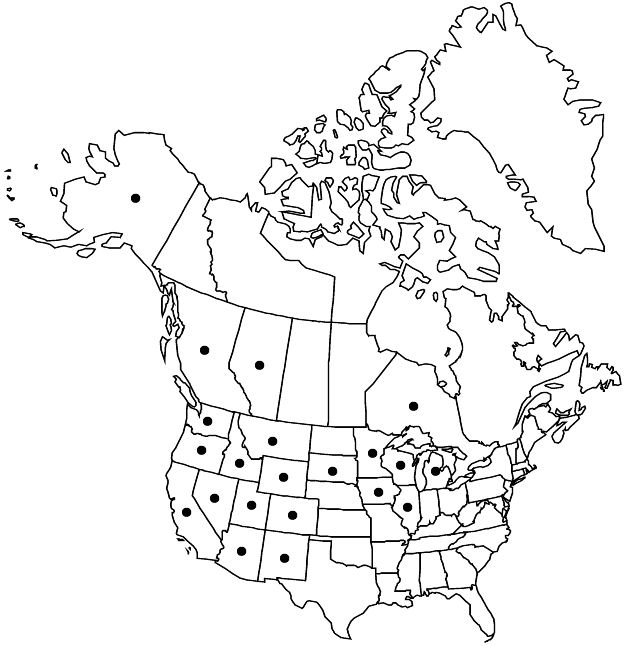Difference between revisions of "Rubus parviflorus"
Gen. N. Amer. Pl. 1: 308. 1818.
FNA>Volume Importer |
GeoffLevin (talk | contribs) m (Further fixed italics in discussion) |
||
| (3 intermediate revisions by 2 users not shown) | |||
| Line 12: | Line 12: | ||
|name=Rubus parviflorus subsp. velutinus | |name=Rubus parviflorus subsp. velutinus | ||
|authority=(W. H. Brewer) Roy L. Taylor & MacBryde | |authority=(W. H. Brewer) Roy L. Taylor & MacBryde | ||
| + | |rank=subspecies | ||
}} {{Treatment/ID/Synonym | }} {{Treatment/ID/Synonym | ||
|name=R. parviflorus var. velutinus | |name=R. parviflorus var. velutinus | ||
|authority=(W. H. Brewer) Greene | |authority=(W. H. Brewer) Greene | ||
| + | |rank=variety | ||
}} | }} | ||
|hierarchy=Rosaceae;Rosaceae subfam. Rosoideae;Rosaceae tribe Rubeae;Rubus;Rubus parviflorus | |hierarchy=Rosaceae;Rosaceae subfam. Rosoideae;Rosaceae tribe Rubeae;Rubus;Rubus parviflorus | ||
| Line 30: | Line 32: | ||
|elevation=0–3000 m | |elevation=0–3000 m | ||
|distribution=Alta.;B.C.;Ont.;Alaska;Ariz.;Calif.;Colo.;Idaho;Ill.;Iowa;Mich.;Minn.;Mont.;Nev.;N.Mex.;Oreg.;S.Dak.;Utah;Wash.;Wis.;Wyo.;Mexico (Chihuahua). | |distribution=Alta.;B.C.;Ont.;Alaska;Ariz.;Calif.;Colo.;Idaho;Ill.;Iowa;Mich.;Minn.;Mont.;Nev.;N.Mex.;Oreg.;S.Dak.;Utah;Wash.;Wis.;Wyo.;Mexico (Chihuahua). | ||
| − | |discussion=<p><i>Rubus parviflorus</i> is distinguished from other flowering raspberries by its erect, unarmed stems, simple leaves, large flowers, white petals, glabrous, clavate styles, and yellowish to reddish stipitate glands covering most plant parts. A hybrid with <i>R. odoratus</i> (R. | + | |discussion=<p><i>Rubus parviflorus</i> is distinguished from other flowering raspberries by its erect, unarmed stems, simple leaves, large flowers, white petals, glabrous, clavate styles, and yellowish to reddish stipitate glands covering most plant parts. A hybrid with <i>R. odoratus</i> (<i>R.</i> ×<i>fraseri</i> Rehder) is thought to occur in areas of overlap in northern Michigan (E. G. Voss 1972–1996, vol. 2). Varieties and forms have been described based on indument and glandularity of stems, leaves, petioles, pedicels, and sepals (for example, M. L. Fernald 1950). Different variants often occur mixed in the same population and generally do not correspond to definite geographic regions (N. C. Fassett 1941). Plants from coastal California (considered as <i></i>var.<i> velutinus</i>) tend to have densely hairy leaf abaxial surfaces; this variation may be environmentally induced; other <i>Rubus</i> species show the same pattern (for example, <i>R. spectabilis</i> var. <i>franciscanus</i>) in that area. Wild thimbleberries are collected in Keweenaw Peninsula, Michigan, and are used in beverages and especially for jam.</p><!-- |
--><p><i>Rubus parviflorus</i> is typically associated with western North America but was originally described from plants at its eastern range limit in northern Michigan. The Great Lakes populations are disjunct from western mountain populations by around 600 miles.</p><!-- | --><p><i>Rubus parviflorus</i> is typically associated with western North America but was originally described from plants at its eastern range limit in northern Michigan. The Great Lakes populations are disjunct from western mountain populations by around 600 miles.</p><!-- | ||
| − | --><p>The name <i>Rubus parviflorus</i> var. grandiflorus Farwell, which applies here, is illegitimate.</p> | + | --><p>The name <i>Rubus parviflorus</i> var. <i>grandiflorus</i> Farwell, which applies here, is illegitimate.</p> |
|tables= | |tables= | ||
|references= | |references= | ||
| Line 41: | Line 43: | ||
-->{{#Taxon: | -->{{#Taxon: | ||
name=Rubus parviflorus | name=Rubus parviflorus | ||
| − | |||
|authority=Nuttall | |authority=Nuttall | ||
|rank=species | |rank=species | ||
| Line 56: | Line 57: | ||
|publication year=1818 | |publication year=1818 | ||
|special status= | |special status= | ||
| − | |source xml=https://jpend@bitbucket.org/aafc-mbb/fna-data-curation.git/src/ | + | |source xml=https://jpend@bitbucket.org/aafc-mbb/fna-data-curation.git/src/f50eec43f223ca0e34566be0b046453a0960e173/coarse_grained_fna_xml/V9/V9_65.xml |
|subfamily=Rosaceae subfam. Rosoideae | |subfamily=Rosaceae subfam. Rosoideae | ||
|tribe=Rosaceae tribe Rubeae | |tribe=Rosaceae tribe Rubeae | ||
Latest revision as of 21:48, 14 December 2021
Shrubs, 5–20(–30) dm, unarmed. Stems biennial, erect, sparsely hairy, glabrescent, moderately stipitate-glandular, glands yellowish to reddish, not pruinose. Leaves deciduous, simple; stipules lanceolate to ovate, 5–15 mm; blade orbiculate to reniform, 5–20 × 5–25 cm, base cordate, palmately, shallowly to moderately deeply, (3–)5(–7)-lobed, margins coarsely, irregularly serrate to doubly serrate, apex shortly acuminate to obtuse, abaxial surfaces glabrate to densely hairy, sparsely to moderately stipitate-glandular, glands yellowish to reddish. Inflorescences terminal and axillary, (1–)3–7(–15), cymiform to thyrsiform. Pedicels sparsely to moderately hairy, moderately to densely stipitate-glandular, glands yellowish to reddish. Flowers bisexual; petals white, broadly obovate, (10–)14–22(–28) mm; filaments filiform; ovaries distally densely hairy, styles clavate, glabrous. Fruits red, hemispheric, 1–1.8 cm; drupelets 50–60, coherent, separating from torus. 2n = 14.
Phenology: Flowering May–Aug.
Habitat: Moist areas, open woods, thickets, clearings, stream banks, canyons, grassy meadows, rocky cliffs, sand dunes, upper beaches, dry sandy areas, roadsides
Elevation: 0–3000 m
Distribution

Alta., B.C., Ont., Alaska, Ariz., Calif., Colo., Idaho, Ill., Iowa, Mich., Minn., Mont., Nev., N.Mex., Oreg., S.Dak., Utah, Wash., Wis., Wyo., Mexico (Chihuahua).
Discussion
Rubus parviflorus is distinguished from other flowering raspberries by its erect, unarmed stems, simple leaves, large flowers, white petals, glabrous, clavate styles, and yellowish to reddish stipitate glands covering most plant parts. A hybrid with R. odoratus (R. ×fraseri Rehder) is thought to occur in areas of overlap in northern Michigan (E. G. Voss 1972–1996, vol. 2). Varieties and forms have been described based on indument and glandularity of stems, leaves, petioles, pedicels, and sepals (for example, M. L. Fernald 1950). Different variants often occur mixed in the same population and generally do not correspond to definite geographic regions (N. C. Fassett 1941). Plants from coastal California (considered as var. velutinus) tend to have densely hairy leaf abaxial surfaces; this variation may be environmentally induced; other Rubus species show the same pattern (for example, R. spectabilis var. franciscanus) in that area. Wild thimbleberries are collected in Keweenaw Peninsula, Michigan, and are used in beverages and especially for jam.
Rubus parviflorus is typically associated with western North America but was originally described from plants at its eastern range limit in northern Michigan. The Great Lakes populations are disjunct from western mountain populations by around 600 miles.
The name Rubus parviflorus var. grandiflorus Farwell, which applies here, is illegitimate.
Selected References
None.